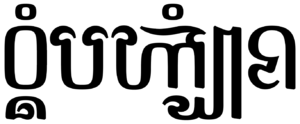Difference between revisions of "Upthsung"
Jump to navigation
Jump to search
m |
m |
||
| (3 intermediate revisions by 2 users not shown) | |||
| Line 9: | Line 9: | ||
'''Upthsung''' is a [[Wikipedia:left to right|left to right]] script used to write [[Ru]], the official language of the [[Ru|Democratic Republic of Ru]], derived from the Mani abugida. | '''Upthsung''' is a [[Wikipedia:left to right|left to right]] script used to write [[Ru]], the official language of the [[Ru|Democratic Republic of Ru]], derived from the Mani abugida. | ||
Upthsung was adapted from the Mani script, which is used in Akulanen. The oldest dated inscription in | Upthsung was adapted from the Mani script, which is used in Akulanen. The oldest dated inscription in Ru was found in Daythion, dated 445 CE. The modern version of the script has not varied significantly throughout the ages, having occasional spelling reforms throughout its history. The current spelling reform is dated 1952. | ||
| Line 16: | Line 16: | ||
<!-- what language family is the language in? why is it classified in that family? --> | <!-- what language family is the language in? why is it classified in that family? --> | ||
== History == | ==History== | ||
<!-- What is the history of the language? | <!-- What is the history of the language? | ||
Where did it come from, who spoke it originally, how has it spread, what contact has it had with other languages ? --> | Where did it come from, who spoke it originally, how has it spread, what contact has it had with other languages ? --> | ||
== | ==Literature== | ||
<!-- How is the language written? What literature is there written in the language? --> | <!-- How is the language written? What literature is there written in the language? --> | ||
[[Category: | [[Category:Writing systems]] [[Category:Ru]] [[Category:Upthsung]] [[Category:Mañic scripts]] | ||
Latest revision as of 10:23, 18 April 2022
Upthsung is a left to right script used to write Ru, the official language of the Democratic Republic of Ru, derived from the Mani abugida.
Upthsung was adapted from the Mani script, which is used in Akulanen. The oldest dated inscription in Ru was found in Daythion, dated 445 CE. The modern version of the script has not varied significantly throughout the ages, having occasional spelling reforms throughout its history. The current spelling reform is dated 1952.
